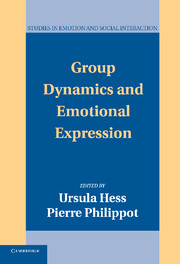Book contents
- Frontmatter
- Contents
- Contributors
- Introduction: The Tale I Read on Your Face Depends on Who I Believe You Are: Introducing How Social Factors Might Influence the Decoder's Interpretation of Facial Expression
- 1 Implications of Ingroup-Outgroup Membership for Interpersonal Perceptions: Faces and Emotion
- 2 When Two Do the Same, It Might Not Mean the Same: The Perception of Emotional Expressions Shown by Men and Women
- 3 It Takes One to Know One Better: Controversy about the Cultural Ingroup Advantage in Communicating Emotion as a Theoretical Rather Than Methodological Issue
- 4 Beauty Is in the Eyes of the Perceiver: The Impact of Affective Stereotyping on the Perception of Outgroup Members' Facial Expressions
- 5 The Perception of Crying in Women and Men: Angry Tears, Sad Tears, and the “Right Way” to Cry
- 6 Tell Me a Story: Emotional Responses to Emotional Expression during Leader “Storytelling”
- 7 Apples and Oranges: Methodological Requirements for Testing a Possible Ingroup Advantage in Emotion Judgments from Facial Expressions
- 8 Others' Faces' Tales: An Integration
- Index
- Cambridge Cultural Social Studies
- References
7 - Apples and Oranges: Methodological Requirements for Testing a Possible Ingroup Advantage in Emotion Judgments from Facial Expressions
Published online by Cambridge University Press: 06 August 2009
- Frontmatter
- Contents
- Contributors
- Introduction: The Tale I Read on Your Face Depends on Who I Believe You Are: Introducing How Social Factors Might Influence the Decoder's Interpretation of Facial Expression
- 1 Implications of Ingroup-Outgroup Membership for Interpersonal Perceptions: Faces and Emotion
- 2 When Two Do the Same, It Might Not Mean the Same: The Perception of Emotional Expressions Shown by Men and Women
- 3 It Takes One to Know One Better: Controversy about the Cultural Ingroup Advantage in Communicating Emotion as a Theoretical Rather Than Methodological Issue
- 4 Beauty Is in the Eyes of the Perceiver: The Impact of Affective Stereotyping on the Perception of Outgroup Members' Facial Expressions
- 5 The Perception of Crying in Women and Men: Angry Tears, Sad Tears, and the “Right Way” to Cry
- 6 Tell Me a Story: Emotional Responses to Emotional Expression during Leader “Storytelling”
- 7 Apples and Oranges: Methodological Requirements for Testing a Possible Ingroup Advantage in Emotion Judgments from Facial Expressions
- 8 Others' Faces' Tales: An Integration
- Index
- Cambridge Cultural Social Studies
- References
Summary
Author's Note
I thank Marija Drezgic, Shannon Pacaoa, Janice Cheng, Aaron Estrada, and Victoriya Tebeleva for their assistance in the general laboratory program.
Correspondence concerning this chapter should be addressed to David Matsumoto, Department of Psychology, San Francisco State University, 1600 Holloway Avenue, San Francisco, CA 94132; telephone (415) 338-1114, fax (510) 217-9608, or e-mail at dm@sfsu.edu.b.
Introduction
The ability to recognize certain facial expressions of emotion is universal. Studies reported more than thirty years ago provided the first systematic and reliable evidence of this (Ekman, 1972; Ekman & Friesen, 1971; Ekman, Sorenson, & Friesen, 1969; Izard, 1971), and those studies have been replicated time and again by different researchers using different methodologies (Elfenbein & Ambady, 2002b; Matsumoto, 2001). A recent meta-analysis including 168 data sets involving judgments of emotion in different cultures summarized this area and indicated that the core components of emotion recognition are pancultural and likely biological (Elfenbein & Ambady, 2002b).
However, there are also cultural differences in emotion judgments. One of the first studies that documented cultural differences reported correlations between Hofstede's cultural dimension data (Hofstede, 1980, 1984) with accuracy rates of judgments of universal facial expressions of emotion across cultures in an ecological analysis (Matsumoto, 1988). Subsequent studies showed that cultural differences existed between Americans and Japanese (Matsumoto, 1992), and then across a broader range of cultures (Biehl et al., 1997) and ethnic groups (Matsumoto, 1993), and in bilinguals depending on the language in which they are tested (Matsumoto & Assar, 1992).
- Type
- Chapter
- Information
- Group Dynamics and Emotional Expression , pp. 140 - 181Publisher: Cambridge University PressPrint publication year: 2007
References
- 3
- Cited by



